Pro Logic IIx: What it Is, How it Works, and a Comparison with Other Formats March, 2004 Brian Florian
Introduction
Surround sound decoding is getting out of hand. I've been in the computer industry for a decade so I understand that there are exponential advances in technology, but even with that in perspective, we have to question the road this industry is on. Confusion abounds. Arguments arise on forums over which is the best technology.
The "latest and greatest" is Dolby's Pro Logic IIx, first demonstrated for us at CEDIA in September, 2003, and which is now available on many products. But before we get to that, let's take a stroll down memory lane and talk about how surround sound has changed over the years.
Matrix Decoding (a quick refresher)
Matrix Decoder or Matrix Surround Decoder are the most generic terms available for the principle behind all of the surround sound technologies based on a two-channel carrier.
In such systems, all sounds are contained within two channels, customarily referred to as "Left Total" and "Right Total". Using a variety of technologies, the system delivers (at least) four channels at playback: Left, Center, Right, and "Surround".
For complete details on how this actually works, please see our Article on Dolby Pro Logic / Pro Logic II. Basically, sounds that are common to both original channels and in phase are delivered to the center channel, and sounds that are common to both original channels but out of phase are delivered to the surround channel.
While Dolby's Cinema Matrix system, Dolby Stereo, and the consumer equivalent, Dolby Pro Logic, are not the only Matrix Surround Sound systems in the world, but they are arguably the best as evidenced by their commercial success. Nothing else comes close. For that reason alone, I will regard Pro Logic as the baseline.
Discrete Decoding (a quick refresher)
Whereas any Matrix decoder derives multiple channels from two, when we talk about a "Discrete" Surround Sound System, each and every channel is unique at the source. There is a carrier channel for every playback channel. When we say "5.1", we mean 6 channels: 5 Main Channels (Left, Center, Right, Left Surround, Right Surround) and 1 LFE (Low Frequency Effects) channel. We could also have "4.0" (where we have Left, Center, Right, and Surround), or we could have "6.1", or any conceivable combination thereof, technology permitting. The point is, whenever we say "Discrete", or use the X.X designation, we are talking about separate carrier channels for every playback channel.
A Summary of Available Formats
With those clarifications in mind, lets take a look at what is on the table today, in the order they came to market
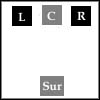 Dolby Pro Logic.
This is a Matrix decoder delivering 4 output channels,
Left / Center / Right / Surround. Virtually every movie since 1977 has
had a two-channel soundtrack with Center and Surround folded in. Dolby Pro Logic.
This is a Matrix decoder delivering 4 output channels,
Left / Center / Right / Surround. Virtually every movie since 1977 has
had a two-channel soundtrack with Center and Surround folded in.Note: In our layout icons, we don't show a subwoofer on any of the matrix modes. A subwoofer signal can always be derived through bass management, but it is not technically part of the matrix decode scheme. In contrast, in the 5.1 Discrete carriers, the LFE channel is a channel in and of itself, whether a subwoofer is present or not.
|
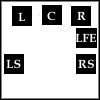 Dolby Digital. Dolby Digital is a flexible discrete digital
technology for carrying audio. It is most often thought of as "5.1",
though it must be noted that it can have just about any combination, including 1.0, 2.0, 4.0, 4.1, and 5.1 etc. In the case of 2.0, where
it is basically a two channel carrier, Dolby Pro Logic may be applied to get
4 output channels. Just about every movie since 1991 has had a Dolby
Digital 5.1 soundtrack while every DVD in the world must include either some
form of Dolby Digital sound (or Linear PCM). Dolby Digital. Dolby Digital is a flexible discrete digital
technology for carrying audio. It is most often thought of as "5.1",
though it must be noted that it can have just about any combination, including 1.0, 2.0, 4.0, 4.1, and 5.1 etc. In the case of 2.0, where
it is basically a two channel carrier, Dolby Pro Logic may be applied to get
4 output channels. Just about every movie since 1991 has had a Dolby
Digital 5.1 soundtrack while every DVD in the world must include either some
form of Dolby Digital sound (or Linear PCM).
|
 DTS.
This is also a discrete audio carrier technology, delivering
either 5.0 (in the commercial cinema system) or 5.1 (in the consumer system).
Not every Hollywood movie gets circulated
with a DTS soundtrack, and DVDs including this optional format are a
minority. DTS.
This is also a discrete audio carrier technology, delivering
either 5.0 (in the commercial cinema system) or 5.1 (in the consumer system).
Not every Hollywood movie gets circulated
with a DTS soundtrack, and DVDs including this optional format are a
minority.
|
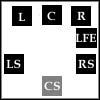 THX Surround EX / Dolby Digital EX. Jointly developed by THX
and Dolby, this playback system first appeared in the consumer market only on THX equipment as
THX
Surround EX but later came to be known as Dolby Digital EX on non-THX
equipment. This system is a "marrying" of discrete and matrix
technology. In a nutshell, a Dolby Digital 5.1 soundtrack is the
source. The Pro Logic matrix decoding technology is used on the two surround channels,
turning them into three: Left Surround, Center Surround, and
Right Surround. While it can rightfully be said this system is
intended for a 6.1 playback layout, THX and Dolby have avoided calling
it a 6.1 delivery system as that would imply it is a discrete format,
which it honestly is not. As of this writing there have been 34
titles made in EX, virtually all including it
when released on DVD. THX Surround EX / Dolby Digital EX. Jointly developed by THX
and Dolby, this playback system first appeared in the consumer market only on THX equipment as
THX
Surround EX but later came to be known as Dolby Digital EX on non-THX
equipment. This system is a "marrying" of discrete and matrix
technology. In a nutshell, a Dolby Digital 5.1 soundtrack is the
source. The Pro Logic matrix decoding technology is used on the two surround channels,
turning them into three: Left Surround, Center Surround, and
Right Surround. While it can rightfully be said this system is
intended for a 6.1 playback layout, THX and Dolby have avoided calling
it a 6.1 delivery system as that would imply it is a discrete format,
which it honestly is not. As of this writing there have been 34
titles made in EX, virtually all including it
when released on DVD.Note: Although it is possible to use one speaker in the center surround position, THX has always advocated, or set a preference for, using two speakers for that one channel.
|
 DTS ES.
This is the same principal as Dolby Digital EX,
and in fact the same source track as a Dolby Digital EX soundtrack, only
at decode time it uses DTS's
own matrix technology to derive the trio of surround channels. DTS ES.
This is the same principal as Dolby Digital EX,
and in fact the same source track as a Dolby Digital EX soundtrack, only
at decode time it uses DTS's
own matrix technology to derive the trio of surround channels.
|
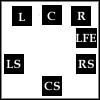 DTS ES Discrete.
This is the same layout as Dolby Digital EX / DTS ES,
except that the sixth main channel is actually discrete with its own carrier
channel at the source. This system may honestly be referred to as
"6.1". There have been no Hollywood movies circulated
with this type of soundtrack (it has never been used in the commercial
systems), and precious few DVDs include a soundtrack remixed for DTS
ES Discrete. DTS ES Discrete.
This is the same layout as Dolby Digital EX / DTS ES,
except that the sixth main channel is actually discrete with its own carrier
channel at the source. This system may honestly be referred to as
"6.1". There have been no Hollywood movies circulated
with this type of soundtrack (it has never been used in the commercial
systems), and precious few DVDs include a soundtrack remixed for DTS
ES Discrete.
|
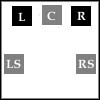 Dolby Pro Logic II
Movie / Pro Logic II Music. Despite its success, Dolby Pro Logic never
really "worked" quite right on music, or more specifically, material which
was not specifically "encoded" for matrix playback. Dolby Pro Logic II
uses advanced Matrix technology to improve on the original in several ways.
It derives 5 channels from the 2 channel carrier (Left / Center / Right /
LeftSurround / RightSurround). It includes "Music" and "Movie" modes
which cater to their namesake's material, Movie being more
center channel concentrated versus Music which is more expansive and
"works" on non-surround encoded material. Dolby Pro Logic II
Movie / Pro Logic II Music. Despite its success, Dolby Pro Logic never
really "worked" quite right on music, or more specifically, material which
was not specifically "encoded" for matrix playback. Dolby Pro Logic II
uses advanced Matrix technology to improve on the original in several ways.
It derives 5 channels from the 2 channel carrier (Left / Center / Right /
LeftSurround / RightSurround). It includes "Music" and "Movie" modes
which cater to their namesake's material, Movie being more
center channel concentrated versus Music which is more expansive and
"works" on non-surround encoded material.
|
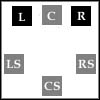 DTS Neo:6 Cinema / DTS Neo:6 Music.
This is DTS's effort at a
Matrix system which takes two-channel source material and delivers up to six
channels at playback: Left / Center / Right / LeftSurround / CenterSurround
/ RightSurround. The "Cinema" vs. "Music" variations cater to their
namesake's material, with Cinema being more center channel concentrated
versus Music which is more expansive. DTS Neo:6 Cinema / DTS Neo:6 Music.
This is DTS's effort at a
Matrix system which takes two-channel source material and delivers up to six
channels at playback: Left / Center / Right / LeftSurround / CenterSurround
/ RightSurround. The "Cinema" vs. "Music" variations cater to their
namesake's material, with Cinema being more center channel concentrated
versus Music which is more expansive.
|
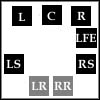 THX Ultra2 Cinema / Music
/ Game.
THX felt that people wanted to make more use of the extra speakers
they had purchased for EX. In response to that, they introduced these
three new playback systems. Four channels are created from the
two surrounds
using a technology THX calls ASA (Adaptable Surround Array) to
tailor the rear channels to "work" with non-EX Encoded material, with each mode tweaked to work
best on its namesake's material. THX Ultra2 Cinema / Music
/ Game.
THX felt that people wanted to make more use of the extra speakers
they had purchased for EX. In response to that, they introduced these
three new playback systems. Four channels are created from the
two surrounds
using a technology THX calls ASA (Adaptable Surround Array) to
tailor the rear channels to "work" with non-EX Encoded material, with each mode tweaked to work
best on its namesake's material.Note: THX Ultra2 modes use two speakers for the "rear" surround channels, ideally placed adjacent to each other. This we are told permits THX the greatest control over the surround field being directional vs. expansive in the different modes.
|
 Dolby Pro Logic IIx. There are actually two parts to Pro Logic
IIx. The first is its role as a classic Matrix decoder. It
distinguishes itself by delivering up to seven channels (as compared to Pro Logic II's
five, or Pro Logic's four). Like Pro Logic II, it includes Music and
Movie modes. Note that both the side channels and rear channels are stereo. Dolby Pro Logic IIx. There are actually two parts to Pro Logic
IIx. The first is its role as a classic Matrix decoder. It
distinguishes itself by delivering up to seven channels (as compared to Pro Logic II's
five, or Pro Logic's four). Like Pro Logic II, it includes Music and
Movie modes. Note that both the side channels and rear channels are stereo.Pro
Logic IIx also plays a role with Discrete 5.1 material by deriving |
Should You Specifically Shop for a Receiver that has Pro Logic IIx?
The answer depends.
First, if your system consists of five Main speakers, in terms of Matrix decoders you need go no further than Dolby Pro Logic II. Everything else is a stab at making use of center surround/rear speakers. If you are staying with 5.1 and don't have Pro Logic II, but like to listen to music, you may want to consider trading up to hardware that has Pro Logic II or Pro Logic IIx. It would be the difference between listening to music in two-channel versus surround, while also benefiting all Dolby Stereo movie material you may have (VHS, Laserdisc, older movies on DVD, and even most TV material).
If you are into THX and have an Ultra2 SSP or Receiver, I don't think there would be much point to rushing out and replacing your hardware just to get Pro Logic IIx. Virtually all Ultra2 units include Pro Logic II for music, while the Ultra2 modes in principal have much the same goal as Pro Logic IIx (when applied to a 5.1 discrete soundtrack). One could argue that Dolby's take on it works/sounds better or vice versa, but in practice, having heard both, I don't think we are apt to appreciate any such difference on a daily basis.
While inevitably all SSPs and Receivers will in time have Pro Logic IIx, the only consumers who might replace their hardware to get it would be those who have an obsession with using all their speakers all the time, or those who have to have the latest and greatest at any cost.
Which Matrix Decoder Should You Use?
I don't want to sound rash here, but my answer is: Dolby's (whatever flavor you have). If you want the nitty-gritty, please revisit the extensive listening tests Stacey Spears did in comparing Dolby Pro Logic II to DTS Neo:6, and even the less mainstream Logic7, and Circle Surround. I concur with his summary that Dolby works best in most circumstances. 'Nuff said.
Conclusions
The confusion, this multiple choice game of selecting a surround sound scheme when trying to enjoying a movie or CD, is our own fault. We as consumers bought into EX just because it was so "cool", then we got upset that there were only (at the time), like, five DVDs to play. The industry responded, in spades, with a cornucopia of options for using those extra speakers, and Dolby Pro Logic IIx is the latest of those.
Though I've already made a case for keeping the gear you've got, looking forward, I advocate Pro Logic IIx as the next baseline for a couple reasons: One, it conforms to the speaker layout that our experiences have found works best: seven main channels (plus subwoofer of course). From our first EX trials, we've advocated using two speakers in the rear (even though the center surround in EX is just one channel). A single center surround/rear speaker results in a very narrow sound field regardless of what you're pumping through it. So 7.1 makes sense.
More importantly though, a 7.1 system equipped with Dolby Pro Logic IIx as a base takes the guesswork out of what surround decode scheme you should use: Your only choices are "Music" or "Movie", and that is easy to make. Pro Logic IIx will deliver seven main channels for you, regardless of source, without any concern for whether it will sound "right" or "natural". And it will sound right and natural. Leave it at that.
- Brian Florian -
|
� Copyright
2004 Secrets of
Home Theater & High Fidelity |
![]()



